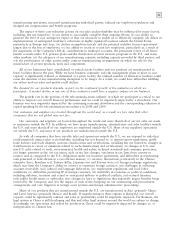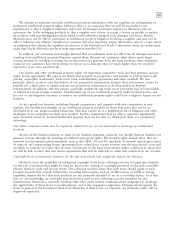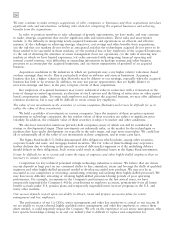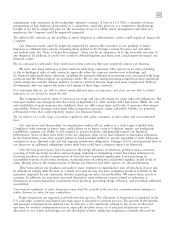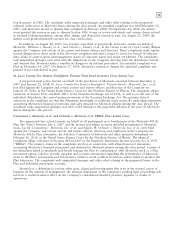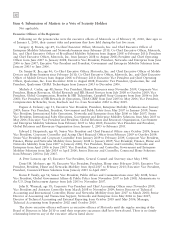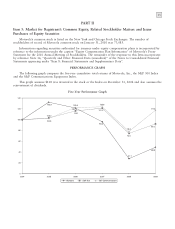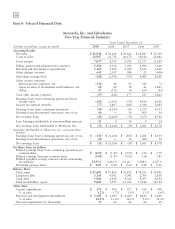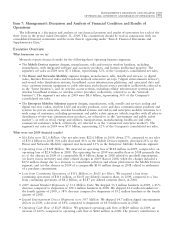Motorola 2009 Annual Report Download - page 35
Download and view the complete annual report
Please find page 35 of the 2009 Motorola annual report below. You can navigate through the pages in the report by either clicking on the pages listed below, or by using the keyword search tool below to find specific information within the annual report.
27
management with experience in the technology industry is intense. A loss of a Co-CEO, a member of senior
management or key employee particularly to a competitor could also place us at a competitive disadvantage,
Further, if we fail to adequately plan for the succession of our Co-CEOs, senior management and other key
employees, the Company could be negatively impacted.
The unfavorable outcome of any pending or future litigation or administrative action could negatively impact the
Company.
Our financial results could be negatively impacted by unfavorable outcomes to any pending or future
litigation or administrative actions, including those related to the Foreign Corrupt Practices Act and other
anti-bribery laws. See ‘‘Item 3—Legal Proceedings.’’ There can be no assurances as to the favorable outcome of
any litigation. In addition, it can be very costly to defend litigation and these costs could negatively impact our
financial results.
We are exposed to risks under large multi-year system contracts that may negatively impact our business.
We enter into large multi-year system contracts with large customers. This exposes us to risks, including:
(i) the technological risks of such contracts, especially when the contracts involve new technology, and
(ii) financial risks under these contracts, including the estimates inherent in projecting costs associated with large
contracts and the related impact on operating results. We are also facing increasing competition from traditional
system integrators and the defense industry as system contracts become larger and more complicated. Political
developments also can impact the nature and timing of these large contracts.
It is important that we are able to obtain many different types of insurance, and if we are not able to obtain
insurance we are forced to retain the risk.
The Company has many types of insurance coverage and also self-insures for some risks and obligations. The
insurance market was disrupted after the events of September 11, 2001 and the 2005 hurricanes. While the cost
and availability of most insurance has stabilized, there are still certain types and levels of insurance that remain
unavailable. Natural disasters and certain risks arising from securities claims and public liability are potential
self-insured events that could negatively impact our financial results.
We are subject to a wide range of product regulatory and safety, consumer, worker safety and environmental
laws.
Our operations and the products we manufacture and/or sell are subject to a wide range of global laws.
Compliance with existing or future laws could subject us to future costs or liabilities, impact our production
capabilities, constrict our ability to sell, expand or acquire facilities, and generally impact our financial
performance. Some of these laws relate to the use, disposal, clean up of, and exposure to hazardous substances.
In the United States, laws often require parties to fund remedial studies or actions regardless of fault. Motorola
continues to incur disposal costs and has ongoing remediation obligations. Changes to U.S. environmental laws or
our discovery of additional obligations under these laws could have a negative impact on Motorola.
Over the last several years, laws focused on: the energy efficiency of electronic products and accessories;
recycling of both electronic products and packaging; reducing or eliminating certain hazardous substances in
electronic products; and the transportation of batteries have expanded significantly. Laws pertaining to
accessibility features of electronic products, standardization of connectors and power supplies, sound levels of
music playing devices, the transportation of lithium-ion batteries and other aspects are also proliferating.
These laws impact our products and make it more expensive to manufacture and sell products. It may also
be difficult to comply with the laws in a timely way and we may not have compliant products available in the
quantities requested by our customers, thereby impacting our sales and profitability. We expect these trends to
continue. In addition, we anticipate increased demand to meet voluntary criteria related to reduction or
elimination of certain hazardous constituents from products, increasing energy efficiency, and providing additional
accessibility.
Government regulation of radio frequencies may limit the growth of the wireless communications industry or
reduce barriers to entry for new competitors.
Radio frequencies are required to provide wireless services. The allocation of frequencies is regulated in the
U.S. and other countries and limited spectrum space is allocated to wireless services. The growth of the wireless
and personal communications industry may be affected: (i) by regulations relating to the access to allocated
spectrum for wireless communication users, especially in urban areas, (ii) if adequate frequencies are not
allocated, or (iii) if new technologies are not developed to better utilize the frequencies currently allocated for






